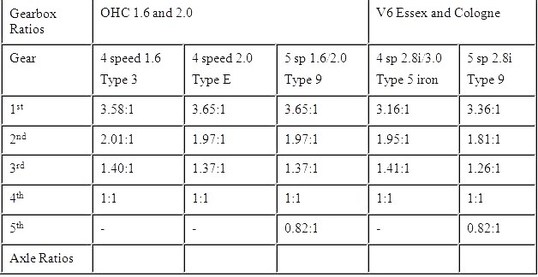1982: The Type 9 goes into production.
With the introduction of the Ford Sierra for Model Year 1983 (Which started production in August 1982) Ford took the plunge and introduced the Type 9. At this point it’s important to remember that the T9 was initially offered as an option on certain variants; not standard fitment across the range. It may be of interest to note that it was common practice to fit a common transmission across all passenger/ light commercial applications – therefore the inclusion of the Transit and P100 (A hybrid light pick-up developed in South Africa around the Cortina and later carried over to the Sierra)
The Type 9 was offered on the following models/ variants:
Sierra 1.6/1.8/2.0/2.3
Sierra XR4i
Sierra XR4x4 2.8
Capri 1.6/2.0
Capri 2.8
Granada 2.0/ 2.3/2.5d
Granada 2.8/ 2.8i
Merkur XR4Ti. (American market)
Scorpio 4 X 4
Transit(LCV)
P100 (LCV)
Ford owners could now enjoy the driving experience previously reserved for owners of more expensive luxury vehicles. The lowering of engine speed for a given road speed made open road driving a more relaxed affair, while (under most conditions) reducing fuel consumption, and even wear and tear on the mechanicals.
By way of example:
The Ford Capri 2.8 injection with a 4 speed gearbox, fitted with a 4th gear ratio of 1: 1 and a final drive ratio of 3.09, had the engine turning at 3409 RPM at 120km/h (70 MPH); whereas a vehicle fitted with the 5 speed unit with a 5th gear ratio of 1: 0.825 and the same final drive ratio of 3.09 had the engine turning at 2899 RPM at the same speed. This 15% drop in engine revs did not go unnoticed, with the car receiving rave reviews from car testers and the public.
The Type 9 was offered on the following models/ variants:
Sierra 1.6/1.8/2.0/2.3
Sierra XR4i
Sierra XR4x4 2.8
Capri 1.6/2.0
Capri 2.8
Granada 2.0/ 2.3/2.5d
Granada 2.8/ 2.8i
Merkur XR4Ti. (American market)
Scorpio 4 X 4
Transit(LCV)
P100 (LCV)
Ford owners could now enjoy the driving experience previously reserved for owners of more expensive luxury vehicles. The lowering of engine speed for a given road speed made open road driving a more relaxed affair, while (under most conditions) reducing fuel consumption, and even wear and tear on the mechanicals.
By way of example:
The Ford Capri 2.8 injection with a 4 speed gearbox, fitted with a 4th gear ratio of 1: 1 and a final drive ratio of 3.09, had the engine turning at 3409 RPM at 120km/h (70 MPH); whereas a vehicle fitted with the 5 speed unit with a 5th gear ratio of 1: 0.825 and the same final drive ratio of 3.09 had the engine turning at 2899 RPM at the same speed. This 15% drop in engine revs did not go unnoticed, with the car receiving rave reviews from car testers and the public.
All forward gears were fitted with synchromesh, above table is a brief outline of ratios only

